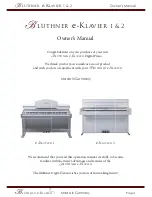
VNA concepts and features
R&S
®
ZNL/ZNLE
294
User Manual 1178.5966.02 ─ 19
R&S
FPL1-B31
R&S
FPL1-B5
For a complete list of options, accessories, and extras refer to the product brochure or
to the "Options" section of the R&S
ZNL/ZNLE product pages on the Internet. The fol-
lowing sections provide an introduction to the software and hardware options described
in this documentation.
●
For the R&S
ZNL, some hardware and software options depend on the
. These options are only available if the R&S
ZNLxx is equipped
with the spectrum analysis hardware option R&S
ZNLxx-B1. For a description of
these options, refer to the Spectrum Mode user manual.
For the R&S
ZNLE and for R&S
ZNL14 and R&S
ZNL20 with serial numbers below
101200, a spectrum analysis option is
not available
.
●
The additional hardware options are a subset of the hardware options of the identi-
cally constructed spectrum analyzer R&S
FPL100x. For this reason, they are pre-
fixed by R&S
FPL1 (instead of R&S
ZNL/ZNLE).
●
For the R&S
ZNLE, there are only a few software and hardware options available.
See:
–
Chapter 9.7.1, "Time domain analysis"
–
Chapter 9.7.2, "Distance-to-fault measurements"
–
Chapter 9.7.10, "GPIB interface"
–
Chapter 9.7.11, "Broadband limiter"
–
Chapter 9.7.7, "Lower start frequency for R&S
●
The use of external power meters
for vector network analysis
does not require
any additional hardware or software options on a R&S
ZNL. It is described at the
end of the chapter.
On a R&S
ZNLE, power meters can not be used.
9.7.1
Time domain analysis
Option R&S
ZNL-K2
The network analyzer measures and displays complex S-parameters and other quanti-
ties as a function of the frequency. The measurement results can be filtered and math-
ematically transformed to obtain the time domain representation, which often gives a
clearer insight into the characteristics of the DUT.
Time domain transforms can be calculated in band pass or low pass mode. For the lat-
ter, the analyzer offers the impulse and step response as two alternative transformation
types. A wide selection of windows can be used to optimize the time domain response
and suppress side lobes due to the finite sweep range. Moreover, it is possible to elimi-
nate unwanted responses using a time gate and transform the gated result back into
the frequency domain.
Optional extensions and accessories
















































